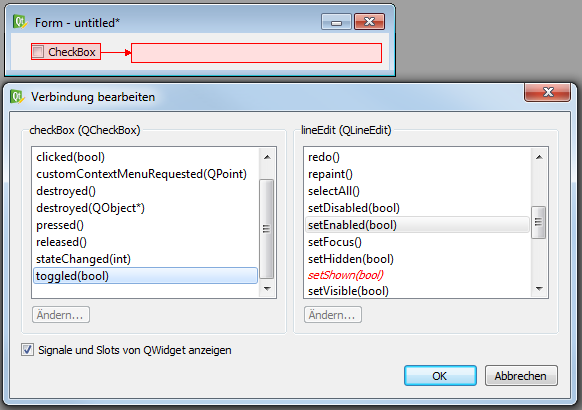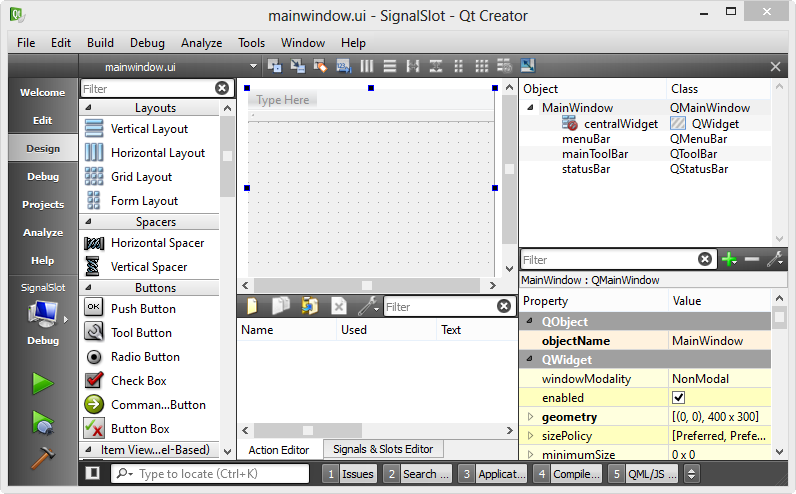Python Qt Slot Decorator
Posted : admin On 4/9/2022- You will find the designer in the site-packages/pyqt5tools directory of your Python environment and should be available in your PATH as designer or pyqt5designer. These packages will also provide pyuic5 for converting Designer files to Python files. It also includes many other utilities like qdbus, qdoc, qmlscene, linguist, and more.
- PyQt is a python binding of the open-source widget-toolkit Qt, which also functions as a cross-platform application development framework. Qt is a popular C framework for writing GUI applications for all major desktop, mobile, and embedded platforms (supports Linux, Windows, MacOS, Android, iOS, Raspberry Pi, and more).
- While we can use the QDialog class to build dialogs in Python code, we can also use Qt Designer to create custom dialogs in the drag and drop editor. Qt Designer is a Qt tool that offers a user-friendly GUI that will allow us to quickly create and set up our dialogs and windows. Creating Dialogs With Qt Designer.

- PyQt5 Tutorial
- PyQt5 Useful Resources
PyObject is passed as direct pointer, which allows to pass/return any Python object directly to/from a Qt slot that uses PyObject. as its argument/return value. All Qt QVariant types are implemented, PythonQt supports the complete Qt API for these objects.
- Selected Reading
Unlike a console mode application, which is executed in a sequential manner, a GUI based application is event driven. Functions or methods are executed in response to user’s actions like clicking on a button, selecting an item from a collection or a mouse click etc., called events.
Widgets used to build the GUI interface act as the source of such events. Each PyQt widget, which is derived from QObject class, is designed to emit ‘signal’ in response to one or more events. The signal on its own does not perform any action. Instead, it is ‘connected’ to a ‘slot’. The slot can be any callable Python function.
Using Qt Designer's Signal/Slot Editor
Python Qt Designer Slot
First design a simple form with a LineEdit control and a PushButton.
It is desired that if button is pressed, contents of text box should be erased. The QLineEdit widget has a clear() method for this purpose. Hence, the button’s clicked signal is to be connected to clear() method of the text box.
To start with, choose Edit signals/slots from Edit menu (or press F4). Then highlight the button with mouse and drag the cursor towards the textbox
Python Qt Designer
As the mouse is released, a dialog showing signals of button and methods of slot will be displayed. Select clicked signal and clear() method
The Signal/Slot Editor window at bottom right will show the result −

Save ui and Build and Python code from ui file as shown in the below code −
Generated Python code will have the connection between signal and slot by the following statement −
Python Qt Slot Decorator Tool
Run signalslot.py and enter some text in the LineEdit. The text will be cleared if the button is pressed.
Building Signal-slot Connection
Instead of using Designer, you can directly establish signal-slot connection by following syntax −
Suppose if a function is to be called when a button is clicked. Here, the clicked signal is to be connected to a callable function. It can be achieved in any of the following technique −
Example

In the following example, two QPushButton objects (b1 and b2) are added in QDialog window. We want to call functions b1_clicked() and b2_clicked() on clicking b1 and b2 respectively.

When b1 is clicked, the clicked() signal is connected to b1_clicked() function −
When b2 is clicked, the clicked() signal is connected to b2_clicked() function.
Python Qt Slot Decorator Rods

The above code produces the following output −